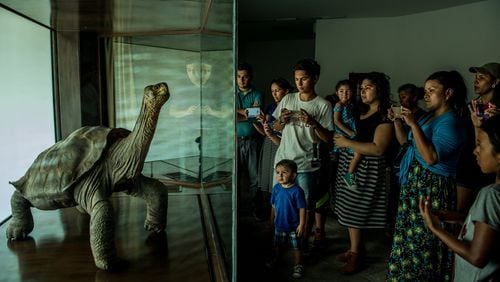Story by Pamela A. Keene
More than 15 years ago, my husband Rick saw Lonesome George at the ripe old age of 91. He encountered the Pinta Island giant land tortoise, believed to be the last of his sub-species, on a Galapagos Islands visit that included a stop at the Charles Darwin Research Station. Lonesome George had been moved there in 1971 and made it his home until he died of natural causes in 2012 at the age of 102.
In 2017, Rick and I journeyed together to the Southern Hemisphere and the Galapagos, located 600 miles west of Ecuador. It was my first chance to experience the wonders that naturalist Charles Darwin wrote about more than 180 years ago. Traveling on the Galaxy II 16-passenger ship in the fleet of Overseas Adventure Travel (oattravel.com), 11 of us walked with the wildlife, snorkeled with starfish and immersed ourselves in a land like no other.
Travel options to the Galapagos range from chartered live-aboard boats to land-based stays at various resorts, hotels and Airbnb units on the larger islands. Tour companies offer packages to accommodate visitors, and some can create custom itineraries. In 1959, the Ecuadorian government created the Galapagos National Park (galapagos.gob.ec), which was named a UNESCO World Heritage Site in 1978. And as of 1986, the Galapagos Marine Resources Reserve was created to protect the surrounding waters.
The legendary Galapagos archipelago comprises 13 major islands, six smaller islands and more than 40 little islands, called islets. Two major airports on Baltra and San Cristobal provide access from the mainland, flying directly either from Quito, Ecuador’s capital, or Guayaquil on the coast.
Our Galapagos trip was part of a 19-day adventure that included Ecuador and the Amazon Rain Forest. After flying from Quito through Guayaquil to the airport on Baltra, we took a bus, then a ferry and a van to Puerto Ayora, where we toured the Charles Darwin Research Station (darwinfoundation.org/en). I got my chance to see Lonesome George, now taxidermied following posthumous preservation at the Museum of Natural History in New York, in a a specially designed display.
As we made our way to board the ship, sea lions napped on park benches along the dock. We gingerly boarded our pangas [inflatable Zodiac boats] powered by outboard motors, their propellers surrounded by metal frames to protect the wildlife, to be transported to the Galaxy II.
“There are no natural predators in the Galapagos, so you will find that the animals have little fear,” says our guide and naturalist Jessica Salas. “However, there is a push-me, pull-me balance between nature and man. Because of this, travel here is moderated and regulated. People are not allowed on certain islands without naturalist or guide that’s approved by the National Park Service. And our itinerary may change, because the number of people is limited on the islands. Also, take nothing but photographs and memories, and leave nothing behind.”
Each evening, our next-day, white-board itinerary helped build the anticipation for close encounters. It always included a siesta following a seated lunch. “You’re on vacation and here in the Galapagos, siestas are mandatory,” Jessica says. No one argued.
We traveled more than 300 miles on the Galaxy II, crossing the Equator twice. With nearly a dozen anchorages in eight days, we visited sandy beaches, lava islands, mangrove inlets, quiet lagoons and open seas. December to May is the wet season, but in March, it’s hot and humid, the climate and water temperature moderated by the Panama Current.
Our trip provided several opportunities to snorkel, the water being warmer than from June to November, when the Humboldt Current moves northward from Antarctica.
Twice-daily trips from the ship put us on nearly a half-dozen types of terrain where lava lizards basked in the sun, marine iguanas slithered across rocky or sandy ground into the water, and bright-orange Sally Lightfoot crabs skittered along the moss-covered edges of tidal pools.
Around every turn, a new surprise awaited. As we approached a mountainside cave in our pangas, a dozen blue-footed boobies shared their perches with flightless cormorants and pelicans. A circumnavigation of a small, rocky island revealed 20 or so penguins sunning, swimming and preening. Various people in our group pointed out camouflaged Darwin finches, swimming spotted eagle/leopard rays and frigate birds in flight.
The archipelago provides a home to more than 50 species of animals and birds found nowhere else on the planet. But, from his resting place at Darwin Station, Lonesome George remains the enduring symbol of everything Galapagos.
Insider Tip
Train for your trip to improve your mobility, balance and endurance. You’ll be doing a great deal of walking and climbing in hot and humid conditions, and you’ll want to be able to keep up with your fellow travelers. Bring plenty of sunscreen and apply it often — after all, you’re on the Equator.
Pamela A. Keene has lived in Atlanta since 1981 and written for publications across the Southeast.
About the Author






